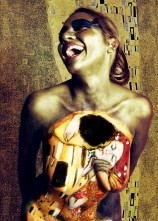A Painter of Bodies
GALO: What challenges do you experience when working with a live canvas?
DS: The main challenge, which also is an advantage, of working with human body as a canvas is the various shapes and sizes. This means I need to tailor each piece to fit the body shape.
Another challenge is the limited time that I have to finish the painting. Unlike painting on canvas, which I can work on for days or even longer, I can only work on a living canvas for [a] few hours. In most cases, I only have three or four hours [at] maximum. This means I have to learn to work fast.
GALO: Do you feel any kind of remorse or regret when the models wash off your artwork?
DS: Not at all. The ephemeral nature of body painting makes it more valuable and the interesting thing is that people tend to appreciate it more than if it was permanent.
GALO: In past interviews, you have mentioned that you are trying to break boundaries between the viewer and the art by the use of the body as a canvas – that people cannot ignore something that is alive and in front of them. Why do you think there are boundaries between the viewer and the art that hangs on walls in museums and galleries? Do they not become one as they immerse themselves in the painting through their sense of sight or do you believe that because body art is temporary it integrates and communicates with the viewer more?
DS: The main thing that separates most people from art that hangs in museums and galleries is the perception that one needs to have a certain level of art knowledge or sophistication in order to appreciate art. This exclusivity is something that many players in [the] art industry work hard to promote. This intimidates a lot of people to even try to experience the art.
Painting on canvas has become irrelevant for most people. Back in the 1900s, people would go to an art exhibition (salon) to see the latest and greatest in their culture. Now that has been replaced by movies and digital content.
When the art is created on the body, the living canvas provides a new context that makes it more accessible and relevant. The tattoo culture helps shape this perception, making it something that everyone from [a] wide range of backgrounds and social levels can appreciate.
GALO: Is there anything else that you strive to get across through this particular art form?
DS: Yes, appreciation of one’s own body. One thing that’s very rewarding for me as an artist is to see how my art affects the models. Many of them are insecure about their bodies when we begin to work together, but after the painting is done, they see themselves as beautiful masterpieces and find a new appreciation for their bodies.
GALO: What kind of art do you particularly enjoy painting on human bodies?
DS: Stylistically, I’m drawn toward surrealism.
GALO: I noticed that a lot of the body painting that you do involves women. Is there a specific reason why you prefer to work with the body canvas of a woman instead of one of a man?
DS: The main reason is because [the] female body is more interesting to paint than male. The curve and body scape on [the] female body makes painting on it interesting. Another reason is logistically, painting on women is easier, since in general, they have less hair on their bodies.
GALO: Does the same technique that you use while painting on paper, apply to body art?
DS: There are different techniques that apply specifically to applying paint on skin, but for the most part, the painting techniques are similar to the ones that I employ when painting on canvases.
GALO: Tell us a little about your creative process. How do you pick out models; what do you do before starting your work and during?
DS: When selecting models, there are two main considerations: How well their personality and interest fit the concept and how well their look fits the image that I want to create before I start painting. I describe briefly what the model would experience. During the painting process, I make sure the model is comfortable and frequently ask her if she [needs] a break.
(Article continued on next page)

